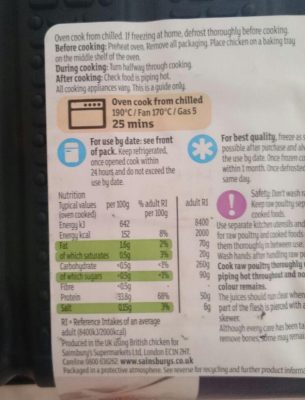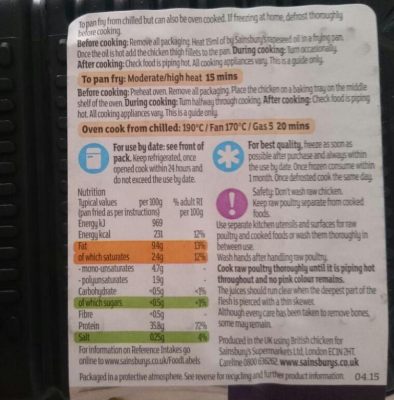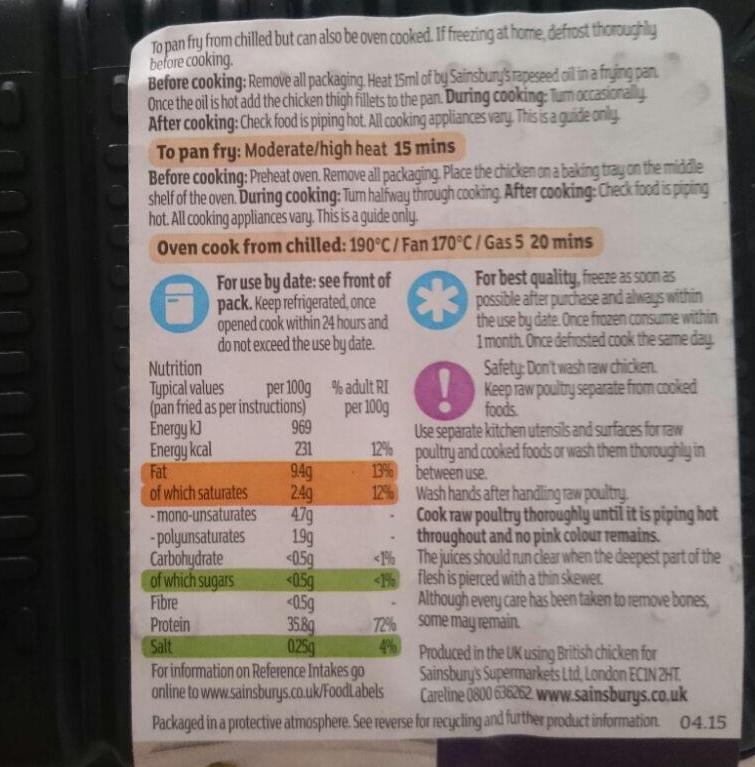A few weeks ago, I was at the supermarket and decided to buy a different cut of meat. As I pay attention to my caloric intake, naturally I checked the nutrition information on the back. I noticed something odd…

This is the labelling for the chicken breasts I regularly buy. It’s quite clear, and gives values per 100g to allow for easy cross-comparison between foods.

However, this is the labelling for chicken thighs. Notice anything different? This gives you the nutrition information for 100g of chicken once it has been pan-fried in oil! This is bizarre – it means that you cannot compare the two products just by looking at the labels. The chicken thighs will obviously have inflated calorie and fat levels due to the oil.
I checked the UK food guidelines, and apparently we follow the EU Food Information for Consumers guidelines. On page 19 of the document I have linked to, it says the following:
EU FIC stipulates that the energy value and amounts of nutrients must be those of the food assold. However, the Regulation also allows you to relate the nutrition information to the foodafter preparation, provided that sufficiently detailed preparation instructions are given.
- Pick up the packets for breasts and thighs
- Notice that the thigh information includes oil but the breasts do not
- Take the packets with me to the oil aisle
- Find the nutrition information for rapeseed oil
- Calculate nutrition for 15ml (if it’s not already stated on the back)
- Subtract this from the nutrition information for thighs
If the aim for food nutrition labelling is to allow easy direct comparison between packaged products (which it must be, given that there are quite a lot of consistency standards that need to be met), then this seems like a massive fail. It more or less undoes what the rest of the legislation aims to do. What is there to stop me selling an inferior product with worse nutritional value when I can provide the information with other added ingredients (whose nutritional values I don’t need to include)?
I turned my attention to the government, and got this reply from a member of the Department of Health:
Thank you for your correspondence of 27 March about nutritional labelling. I have been asked to reply.
I note your concerns.
Nutrition labelling regulations are harmonised in Europe. The new European Regulation 1196/2011 on the provision of food information to consumers (EU FIC) made nutrition labelling mandatory on 13 December 2016 and will help consumers to know, among other things, the amount of fat, saturates, sugars and salt in most pre-packed food. The ingredients list will also complement the nutritional information to make consumers aware of the nutritional content of their food.
In October 2016, the Department of Health published revised guidance on nutrition labelling at:
www.gov.uk/government/publications/technical-guidance-on-nutrition-labelling
The EU FIC stipulates that the energy value and amounts of nutrients must be those of the food as sold. However, the Regulation also allows manufacturers to relate the nutrition information to the food after preparation, provided that sufficiently detailed preparation instructions are given.
I hope this reply is helpful.
This essentially echoes the information I already looked up myself on their website. I do commend the fact that consistency regulation exists in the first place. But marketers and advertisers have been taking advantage of consumers for years by making information as costly to obtain as legally permitted. If regulators really want consumers to have full clarity, then it is only logical (and not difficult) to ensure that they require packaging to denote the nutritional content of the food contained in that package alone, for a fixed mass or volume (i.e. per 100g or 100ml).


Can anyone explain why a ready meal (or other food) stated as being for example 86 kcals per 100g that weighs 400g (on the label) is stated as being 310 kcals total. Sainsburys labels are often like this, much more so than other stores